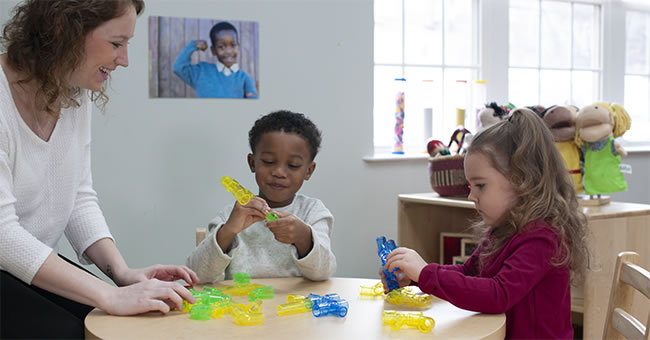
The classroom environment is an essential component for maximizing learning experiences for young children. By infusing elements of key design principles, you can create a classroom that intrigues, invites, and stimulates many senses. The design principles, when layered together, heighten the overall feel of the room. Sparking the interest of a child cannot be done by simply placing furniture in an empty room. The space must be formed with all seven principles to be seen in full bloom. When they are implemented, these design principles will motivate all who enter your space, stimulate those that occupy your space, and enliven those whose interest in the space is beginning to fade.
Principle 1: Nature Inspires Beauty
Just as you are immersed in a natural world of sights, sounds, tastes, smells, and textures, classrooms should reflect the wonders of nature that surround you. As children interact with nature, they deepen their understanding and appreciation of their places and roles as caretakers of the planet.
Principle 2: Color Generates Interest
Color can be a powerful design principle both in positive and negative ways. Proper use of color can create a mood, define a space, and reflect children's homes and communities. Used negatively, color can be overpowering, confusing, and over-stimulating. A neutral background for your classroom with a few well-chosen accent colors will create interest that is focused on the children and adults who inhabit the space.
Principle 3: Furnishings Define Space
Furnishings are used to identify classroom areas such as dramatic play, blocks, art, music, and science. When these furnishings are authentic and sized and placed properly, children's play will increase in quality and depth.
Principle 4: Texture Adds Depth
Texture in the environment offers visual interest and depth and provides children with unique tactile experiences. As children interact with sensory elements, they sharpen their observational skills and fine motor abilities through the languages of weaving, sculptures, and textiles.
Principle 5: Displays Enhance Environment
By eliminating clutter, arranging storage materials, and highlighting children's work, the classroom becomes a backdrop to honor all who occupy the space.
Principle 6: Elements Heighten Ambiance
Multiple sources of light create an ambiance of relaxation and contemplation. By using light in supportive ways, children are able to interact creatively with others and the environment.
Principle 7: Focal Points Attract Attention
When entering the classroom, a distinct focal point can highlight interactive learning centers, children's work, an architectural element, or a beautiful artifact. Focal points invite children to actively engage and participate in the environment.
With easy-to-implement ideas that incorporate the effective use of color, natural elements, lighting, and everyday classroom materials, the photographs and ideas in Inspiring Spaces for Young Children encourage educators to create beautiful and authentic learning spaces. Its companion book, The Rating Observation Scale for Inspiring Environments helps teachers assess their level of growth in creating beautiful classroom environments.
